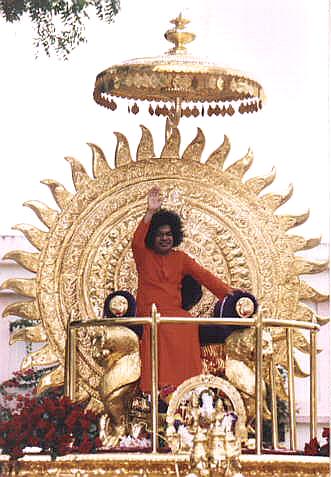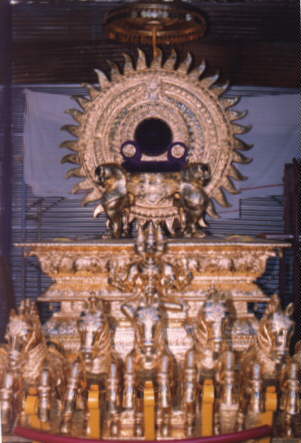
Swami on Golden Suurya Chariot at the Paduka Festival,
September 22, 1997

Golden Suurya Chariot
THE VISION OF SAI SUURYA GAAYATHREE
By Ghandikota V. SubbaRao
[This article is based on the original in Sanaathana Saarathi (Thelugu), October 1997. A more phonetic English spelling of Sanskrith words, as favored by Baba, is used to facilitate better pronunciation.]
The Auspicious Time
It is mentioned in Shuka Naadi, a 5000 year old text of prophecy, that an Avathaarik personality with the name Sathya would be drawn seated in a golden sun chariot by His devotees at around 7:05 AM on Monday, the sixth thithi of Krishna Paksha in the month of Bhaadra-Padha of the year named Eeshwara, i.e. on 22 September 1997. And so it happened in Prashaanthi Nilayam. On that auspicious time and day, as the brilliant rays of the rising Sun streamed in all directions, Bhagavaan Sathya Sai Baba, dressed in His customary ochre robes, emerged out of His Kailaash-like divine residence, the frontage of which was adorned by a striking frieze of Shiva-Nata Raaja. As Bhagavaan slowly climbed the steps of the high golden Sun chariot there were tumultuous sounds of traditional music combined with the loud and mellifluous Vedhik chanting in unison by the yellow, silk-clad students of the Sathya Sai Institute of Higher Learning. Bhagavaan was then seated on a golden throne which was canopied by a golden umbrella. At the back of the throne there was a huge golden disc of the Sun God.
The Legend of Brahma-Ratha
At the driver’s seat of the elevated golden chariot, a big golden idol of the four-faced Creator Brahma was installed. Legend has it that Brahma was the charioteer for Shiva when the latter journeyed along with Shakthi first to Vaikuntha where He halted for a while, and proceeded later to destroy the super demon Thripura Asura. Thripura Asura was the materialist ruler of the triple cities made of gold, silver and iron, the metals of the materialists!
Conquest of Thripura Asura
Similarly, Bhagavaan Shri Sathya Sai Baba, who symbolizes Shiva-Shakthi, journeyed from His Kailaash-like residence in the golden Sun chariot, with a golden image of Brahma in the driver’s seat, to Prashaanthi Mandhiram which is comparable to Vaikuntham, since the former is adorned with striking paintings of Vishnu’s ten principal incarnations, Dhasha Avataars. While Shiva with Shakthi undertook the journey to destroy the demon Thripura Asura, Baba can be said to embark on this memorable golden Sun chariot drive for the purpose of eradicating the triple evils of (1) Eeshanaa-thrayam, (2) Thaapa-thrayam and (3) Dhosha-thrayam.
Eeshanaa-thrayam means the triple negative desires for (1) wealth, (2) wife and (3) children.
Thaapa-thrayam denotes the triple afflictions – Adhibhouthika, Adhi-aathmika and Adhi-dhaivika. These are troubles caused by (1) outside elements (e.g. snakes), (2) own bodily afflictions (e.g. fevers) and (3) sudden fate-induced natural disasters like typhoons and earthquakes.
Finally, Dhosha-thryam are the triple defects: (1) Mala – the soil of past accumulated bad habits, (2) Vikshepa – mental distractions, thoughts and counter thoughts, and (3) Aavarana – the cloud of ignorance or avidhya and the thick shroud of Maaya, the primal worldly illusion.
The inner meaning of the golden Sun Chariot
The golden Sun Chariot, with its rider, its charioteer, its four wheels, its seven yoked horses, etc., connotes inner meanings at the individual or Jeevaathma level on the one hand and also at the collective or Paramaathma level.
At the individual level, the body is like a chariot, which is valuable as a vehicle for our life’s journey. At the cosmic level, the Sun rides His chariot for His journey across the skies, illuminating and energizing the worlds.
The four wheels of the golden chariot may be taken to mean, at the individual level, the two legs and the two hands together connoting instruments of mobile activism. Alternatively, the wheels can mean the four prime driving goals of the life of the individual – Dharma, Artha, Kaama and Moksha, i.e. Righteousness, Wealth, Desire-fulfillment and Liberation. At the cosmic level, the four wheels represent the four directions, or the four Vedhas, which spell out the totality of guiding Knowledge.
At the level of the individual embodied Self, the Seven Horses of the chariot represent the seven prime entities- the five senses, the mind and the intellect. Alternatively and elaborating more fully, the seven entities in the body can be identified as:
|
Golden Suurya Chariot |
The seven horses represent the seven worlds, at the cosmic level.
In regard to the driver of the chariot, it is Buddhi or intelligence at the individual level, and it is the four-faced creator Brahma at the cosmic level.
The background of the golden Sun represents the individualized Life Energy and, at the cosmic level, it is the Sun God or Suurya-Naaraayana or Vishnu, who runs and maintains the cosmos by His unlimited energy.
Sai as Shiva-Shakthi
The seated divinity in the golden Sun chariot is Shiva with Paarvathi, at the primal cosmic level, and at the individualized level it is Sathya Sai – the Divine in human form. The meaning of the word Saayee in Sanskrith is: (Sat = Shiva) + (Ayee = Shakthi) i.e. Shiva-Shakthi!
Baba Himself declared He is Shiva-Shakthi. Svaami also related how Shiva with Shakthi gave a boon to the great sage Bharadhvaaja that He would be born thrice in the sage’s lineage during Kali Yuga. Furthermore, Baba created a picture of Himself in the Shiva Linga, declaring to that great Vedhik scholar, late Ghandikota Subrahmanya Sasthry, that the picture represented Baba’s true form – Nija Svaruupa. It is then that the Vedhik Pandith pronounced Baba as Shiva’s incarnation, based also on a number of Vedhik criteria for establishing the Shiva aspect of Sathya Sai!
The emergence of Sai Suurya Gaayathree
It was on that auspicious day and holy moment that I saw that holy Sai personality – in all His dazzling divine glory seated in the golden Sun chariot with His figure illuminated by the golden rays of the early morning Sun – approaching the Prashaanthi Mandhir. The sight was overwhelming and the holy vibrations reverberated throughout the Sai Kulvanth Hall. It was then that I began to chant spontaneously the Sai Gaayathree Manthra:
OM SAAYEESHVARAAYA VIDHMAHE
SATHYA DHEVAAYA DHEEMAHI
TANNAH SARVAH PRACHODHAYAATH
In that process I began wondering in my mind as to the connection of the Sai Avathaar with the Sun God. Then I mentally began to chant the classical Suurya Gaayathree. While chanting the Sai Gaayathree on the one hand and on the other , mentally contemplating on the Suurya Gaayathree dedicated to the Sun God, I went on mixing the two in such wise that a combination of the two flashed like lightning in my mind. While I contemplated on Svaami in the Suurya-Mandala or the Sun-Disc, unintentionally and spontaneously Sai Suurya Gaayathree emerged as follows:
OM SRI BHAASKARAAYA VIDHMAHE
SAAYI DHEVAAYA DHEEMAHI
THANNAH SUURYAH PRACHODHAYAATH
The significance of Sai Suurya Gaayathree
This manthra means:
We come to know or learn that this effulgent Sai is Divinity Itself.
We meditate on this Divine Radiance.
We pray that this Sai-Sun God guide and lead us on the path of righteousness towards liberation.
In effect we realize that this brilliant Sai-Suurya represents the pure, eternal, illuminating divine consciousness within us.
My joy knew no bounds when it turned out that the total number of letters in this Sai Suurya Gaayathree came to 24, its three parts numbered eight letters each and the Manthra is in the holy Vedhik meter called Gaayathree! There is another interesting feature of this Manthra. When we apply Maharishi Vararuchi’s numbering rules for the respective syllables in the Manthra, the total comes to 95. The first number of this sum, i.e. "9", stands for Shiva or Purusha, and the next number, "5", stands for Shakthi or Prakrithi. In juxtaposition, "95" stands for Shiva and Shakthi, which is the meaning of Saayee (Sah + Ayee) in Sanskrith!
Benefit of chanting Sai Suurya Gaayathree
Sai, meaning Shiva-Shakthi, bestows Aayush, life-breath or longevity and Suurya, the Sun God, bestows Aarogyam, good health. Therefore if this Sai-Suurya Gaayathree is chanted wholeheartedly the Manthra Japa bestows long, healthy divine life to the meditator.
By Ghandikota V. SubbaRao, Prashaanthi Nilayam